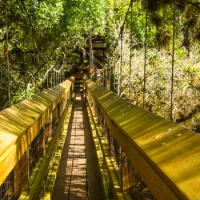A Promise of Paradise: Scottish Heritage in Sarasota
By Compass Rose History Experiences
Nearly four decades before Sarasota became a county, a group of Scottish immigrants landed on our white, sandy shores pursuing the promise of life in a tropical oasis with modern amenities.
But what happens when you move thousands of miles from home, and there’s no home to move into?
Paradise for Sale
In the early 1880s, a newspaper advertisement in Scotland and England told of the idyllic and modern paradise known as “Sarasota”, where you could harvest two crops a year without much effort. The advertisement, taken out by the Florida Mortgage and Investment Company, promised investors an estate of 40 acres on extremely fertile land near a developed and bustling town for the mere price of 100 pounds sterling - an equivalent of roughly $3,300 USD today.
In the early 1880s, a newspaper advertisement in Scotland and England told of the idyllic and modern paradise known as "Sarasota."
A Long Journey from Home
Tempted by the promise of a new beginning in a tropical and fully developed community, 51 colonists from Scotland and England boarded the steamship “Furnesia” in late November of 1885. After a stormy, 15-day trip across the Atlantic, the colonists arrived in New York City on December 15. It was another three days before Mr. Selven Tate, an employee of the Florida Mortgage and Investment Company met up with the colonists to guide them on the next leg of their move. “The Scottish Colony” as they came to be known, got aboard another steamship, “The State of Texas” toward Fernandina, Florida.
After 23 days of traveling, the colonists had many more miles to go.

To make the trek from the East Coast of Florida to Cedar Key, the colonist needed to take a day-and-a-half train ride on a track that was commonly referred to as “two streaks of rust”. It was upon their arrival that Mr. Tate dropped the first bombshell on the colonists -- They would have to wait in Cedar Key for several weeks for lumber to arrive in Sarasota to have portable homes built. Mind you, they were promised (and had purchased) fully complete, permanent homes.
Over a month after leaving Scotland, the travel-weary group finally took their final boat ride to Sarasota. Unfortunately, when they arrived the next morning, the truth could no longer be concealed. The idyllic and modern town of “Sarasota” they were promised only existed in blueprints. Unable to dock, as one had not been built, the boat was forced to anchor on a sandbar.
Over a month after leaving Scotland, the travel-weary group finally took their final boat ride to Sarasota.
Broken Promises
The local rep of the Florida Mortgage and Investment Company, a Mr. A.C. Acton, told them to just be patient. He shared millions of dollars had gone into this project, and they simply arrived earlier than anyone expected.
Sadly, things didn’t really get better for the members of the Scottish Colony. The plots of land they had purchased were far from rich farmland, and was only good for raising cattle. Less than two weeks after they arrived, it snowed. According to legend, the locals thought that the woods had caught fire and that it was raining ash because it never snows in Sarasota.
Less than two weeks after they arrived, it snowed.
By May, most of the Scottish colonists had called it quits. Some moved to northern cities in the United States, some went back to Scotland. The Florida Mortgage and Investment Company, finally realizing their blunder, took action to make their promises a reality, but it was too little, too late for most of the Scottish immigrants.
A Family Determined to Make It Work
One of the few Scottish families that stayed were the Brownings, originally from Paisley, Scotland on the outskirts of Glasgow. Deciding to make the best of the situation, the Browning family built a home on Main Street, just east of Pineapple Avenue.
John Browning was a builder and a Mason. In Paisley, John had owned a lumber mill. His eldest son, Alex, who was 19 at the time they arrived in Sarasota, wrote memoirs later in life, and it’s because of this that we know a lot of Sarasota’s early days. He recalled one of his first jobs swimming out into Little Sarasota Bay anywhere from knee- to shoulder-deep water to place pilings for a dock. He was paid $2 a day for that work. The Brownings decided to make the best of it, and slowly built a home on Main Street, just east of Pineapple.

Alex Browning later assisted in the construction of Henry Plant’s Tampa Bay Hotel, now the University of Tampa. Thanks to his thorough notes, we have a strong understanding of how the hotel was built and the many people involved in its construction. In his memoirs, Alex talked about proudly shaking Mr. Plant’s hand at the grand opening of Tampa Bay Hotel and dancing with Mrs. Margaret Plant.
His contributions to Sarasota can still be enjoyed 100 years later. Alex co-designed the Frances-Carlton Apartments in 1924, as well as designing the bayfront home of William and Marie Selby; now the Selby House Cafe at Marie Selby Botanical Gardens. He even served as Sarasota’s first commissioner of public works from 1920-1921.

More Ways to Experience Sarasota's Scottish Past
If you're interested in dipping your toe into more of this early settlement's history, book a tour with Sarasota Walking Tours. History buffs will love to stroll along Sarasota Bayfront and a walk through charming downtown led by a kilt-wearing tour guide and authentic bagpiping!
The sound of pipes, beating drums, stone throwing events and all around merriment can also be experienced each year during the Sarasota Highland Games & Celtic Festival, an annual tradition from the Scottish Heritage Society of Sarasota around early February each year.
Compass Rose History Experiences is a local company dedicated to connecting people to the history of the Sarasota and Bradenton areas. Through stories of those who came before us, Compass Rose creates meaningful relationships with the past.

![Boat parking at The Crow’s Nest in Venice [Photo: Lauren Jackson]](/sites/default/files/styles/popular_stories_teaser/public/2023-import/The-Crow%2527s-Nest-cropped__OPT.jpg.webp?itok=ycs37M-O)


